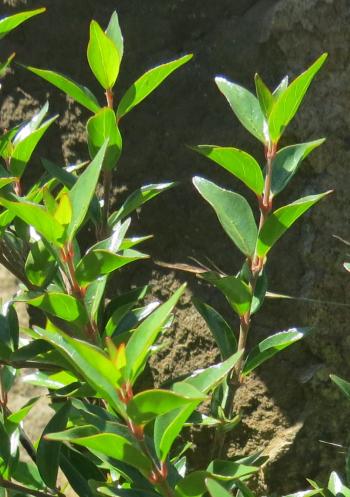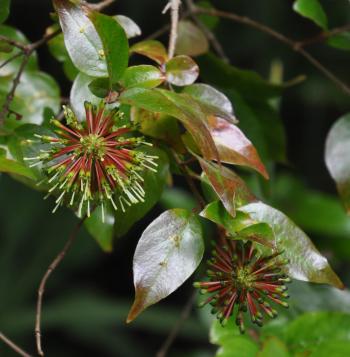Cephalanthus natalensis
Cephalanthus natalensis Oliv.
Family: Rubiaceae
Common names: strawberry bush, tree-strawberry, quinine berry (Eng.); witaarbeibos, witpruim (Afr.); mothotwe, motlholobu (Northern Sotho); murondo, mutsanda (Tshivenda); umfomfo (Siswati); umfimfi, isamfomfo, umfomfo, umfomamasi, umkhombe (isiZulu); morodwe (Balobedu); musipwe, umfunfu (Shona).
SA Tree No: 685
Introduction
A scrambling shrub or small tree with attractive glossy foliage and unusual, pompon-like flowerheads followed by strawberry-like, edible fruits in summer.

Description
Description
A scrambling shrub, climber or small tree, 3–4 m tall, which can grow up to 8 m, depending on the climate of the area. The leaves are simple and opposite, ovate, tapering to a bluntly pointed tip, up to 50 × 25 mm and dark, glossy green. The leaf margin is entire and smooth. The leaves have a pink tinge on the margin and on the stalks, and new growth and autumn leaves are pinkish.

Flowers are tubular, small, greenish white or yellowish green or with a reddish base, in dense, spheroid, terminal heads, about 30 mm in diameter, from winter to early summer (July to November).

Fleshy fruits are clustered in compact, rounded heads, up to 20 mm in diameter, at the ends of branchlets. They look like strawberries, and are whitish or pinkish or reddish when ripe in mid to late summer (December to March).

Conservation Status
Status
According to the Red List of South African plants, this species is not threatened and was given an automated status of Least Concern (LC).
Distribution and habitat
Distribution description
Cephalanthus natalensis occurs naturally in South Africa in the Limpopo, Mpumalanga and KwaZulu-Natal Provinces and in the southern African countries of Zimbabwe, Swaziland and Lesotho. It is found growing on rocky outcrops (koppies), forest margins and mountain grassland.
Derivation of name and historical aspects
History
The genus Cephalanthus was named by Carl Linnaeus (1707–1778), a Swedish botanist, physician and zoologist. The name is derived from the Greek words kephalos, meaning ‘head’ and anthos, meaning ‘flower’, referring to the flowers in dense, rounded heads. The species name natalensis means of Natal, now KwaZulu-Natal.
Cephalanthus is a small genus of 6 species found in tropical regions and North America with 1 species in southern Africa; it falls under the gardenia family (Rubiaceae).

Ecology
Ecology
The leaves are browsed by game and stock. Fruits are eaten by birds, baboons and monkeys.
Uses
Use
The leaves are ground into a powder and used to treat eye problems in cattle. Fruits are edible and can be made into a preserve. The flavour of the fruit is bitter-sweet, a bit like lemon peel, but extremely bitter when unripe, or when bruised or stored. The fruits are also used as a medicine to treat fevers, particularly malaria, although there is no evidence of this treatment being effective. In the garden it can be used for screening.
Growing Cephalanthus natalensis
Grow
It is propagated from seeds, best collected when they have dried on the tree. Sow seeds in spring or early summer. It can also be propagated from softwood cuttings, taken in summer. If treated with rooting hormone and planted in river sand, it takes 4-6 weeks to root, and the rooting percentage is very high.
Plants prefer warm summer temperatures with moderate to high rainfall. First flowers and fruits are likely from about 4 years after sowing. Grow it in a sunny spot and water well in spring and summer.
References
- Boon, R. 2010. Pooley's trees of eastern South Africa, a complete guide. Flora & Fauna Publications Trust, Durban.
- Coates Palgrave, K. 1997. Trees of southern Africa. Struik, Cape Town.
- Foden, W. & Potter, L. 2005. Cephalanthus natalensis Oliv. National Assessment: Red List of South African Plants version 2017.1. Accessed on 2017/07/14
- Fox, F.W. & Norwood Young, E. 1982. Food from the veld: edible wild plants of southern Africa. Delta Books, Cape Town.
- Johnson, D., Johnson, S. & Nichols, G. 2002. Down to Earth, gardening with indigenous shrubs. Struik Publishers, Cape Town.
- Schmidt, E., Lötter, M. & McCleland, W. 2002. Trees & shrubs of Mpumalanga and Kruger National Park. Jacana, Johannesburg.
- Van Wyk, P. & Van Wyk, B. 2013. Field guide to trees of southern Africa. Struik Publishers, Cape Town, Johannesburg.
Credits
Lufuno Nenungwi
Free State National Botanical Garden
August 2017
Plant Attributes:
Plant Type: Scrambler, Shrub, Tree
SA Distribution: KwaZulu-Natal, Limpopo, Mpumalanga
Soil type: Sandy, Loam
Flowering season: Spring, Early Summer, Winter
PH:
Flower colour: Green, Red, Yellow
Aspect: Full Sun, Morning Sun (Semi Shade), Afternoon Sun (Semi Shade)
Gardening skill: Easy
Special Features:
Horticultural zones









Rate this article
Article well written and informative
Rate this plant
Is this an interesting plant?
Login to add your Comment
Back to topNot registered yet? Click here to register.